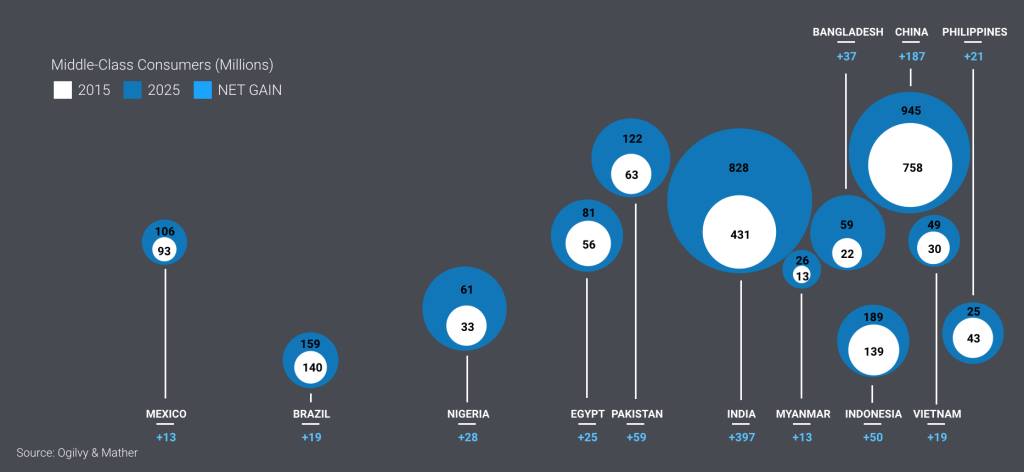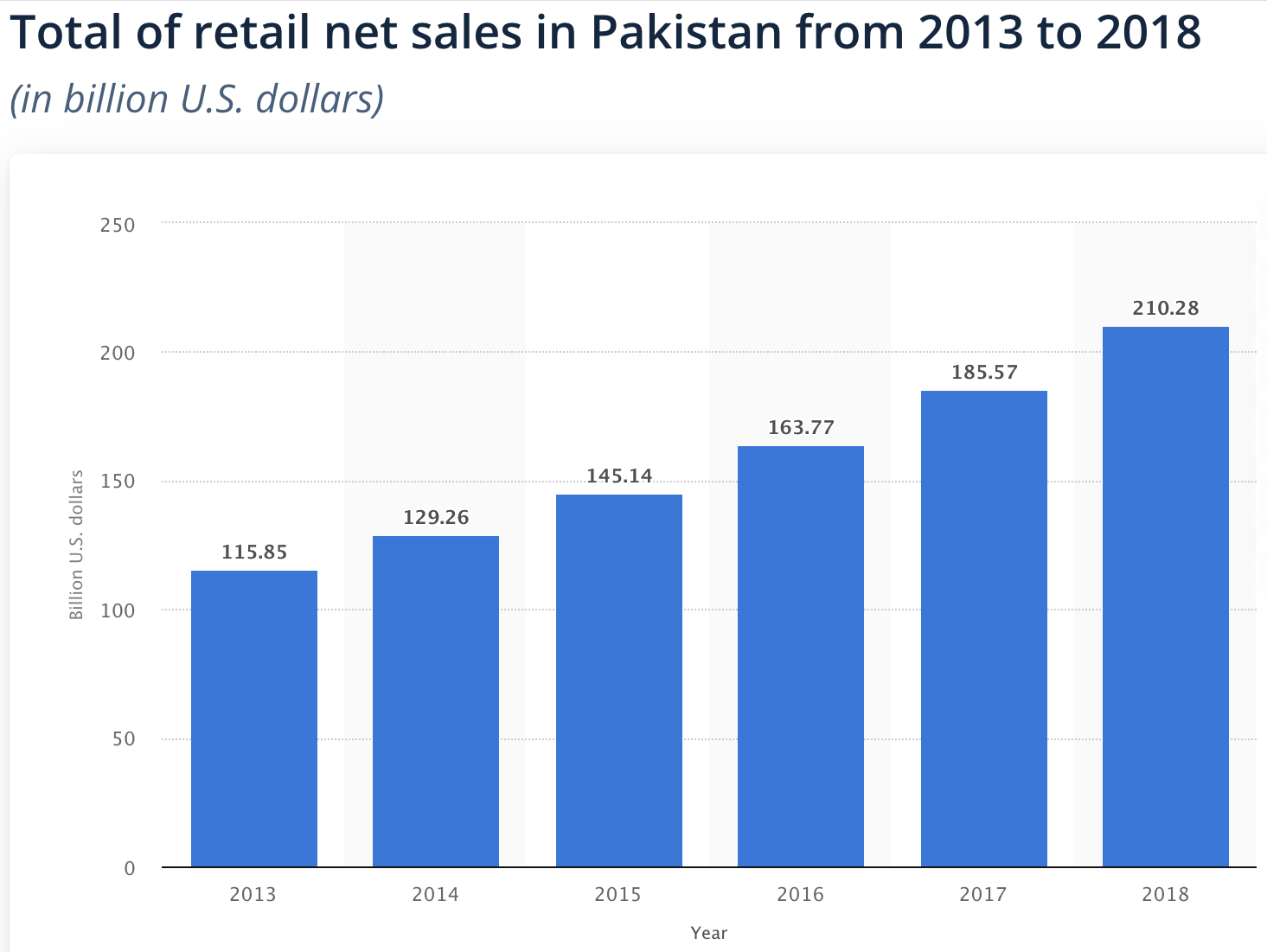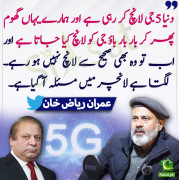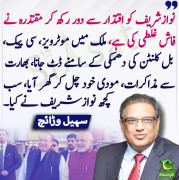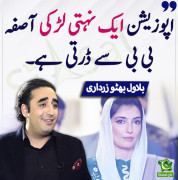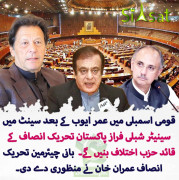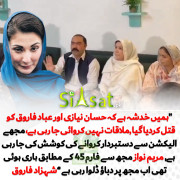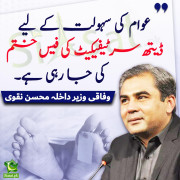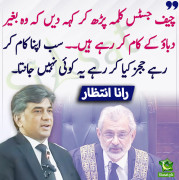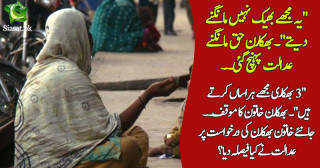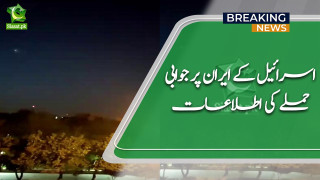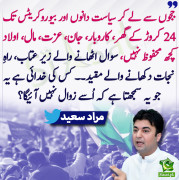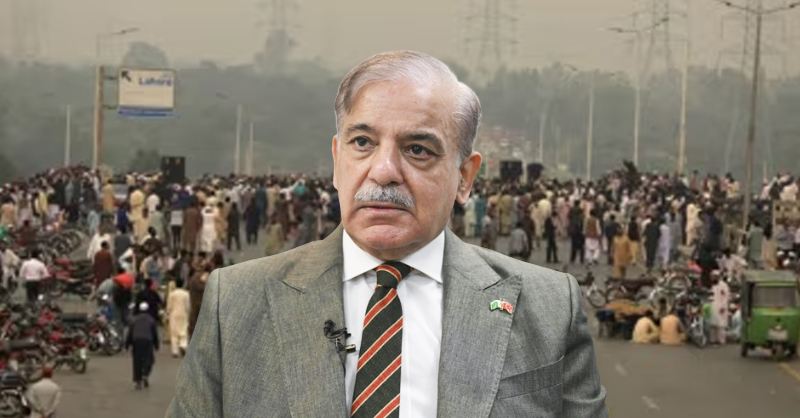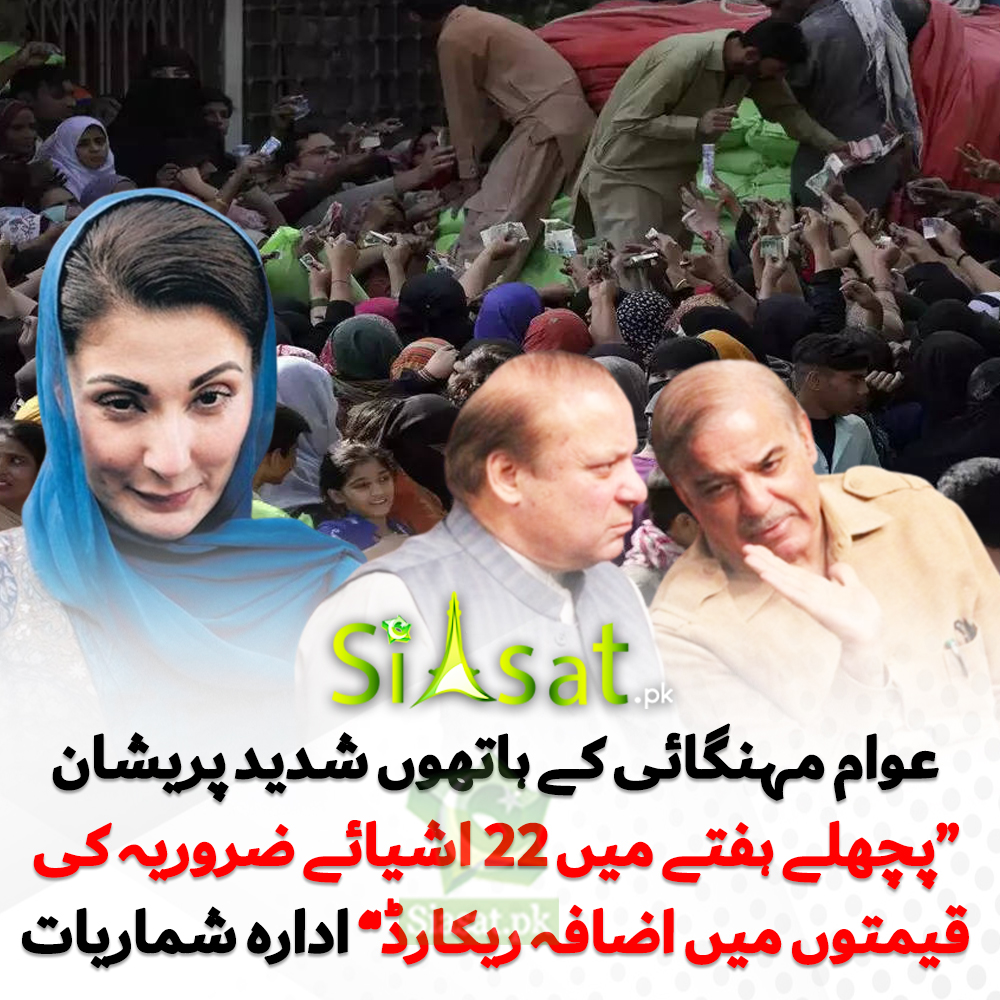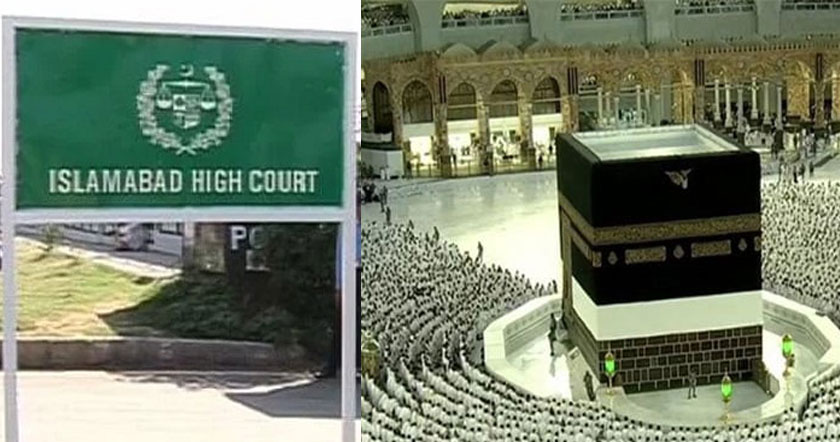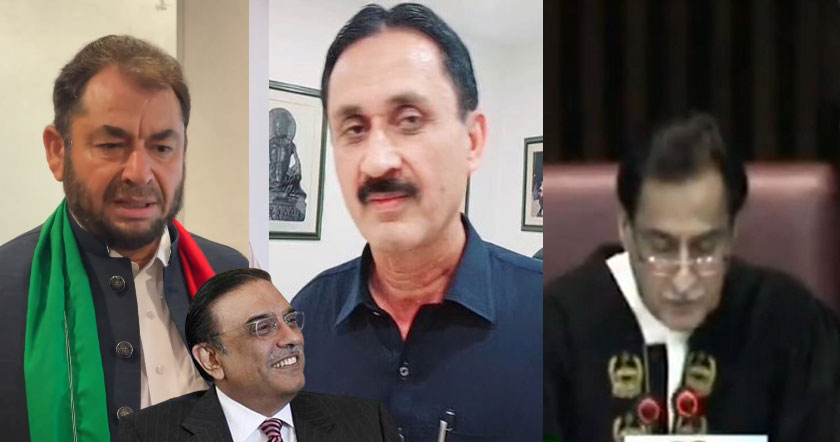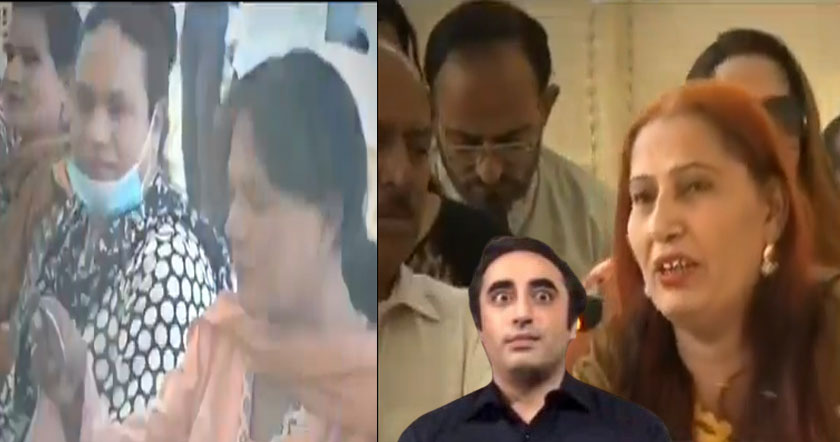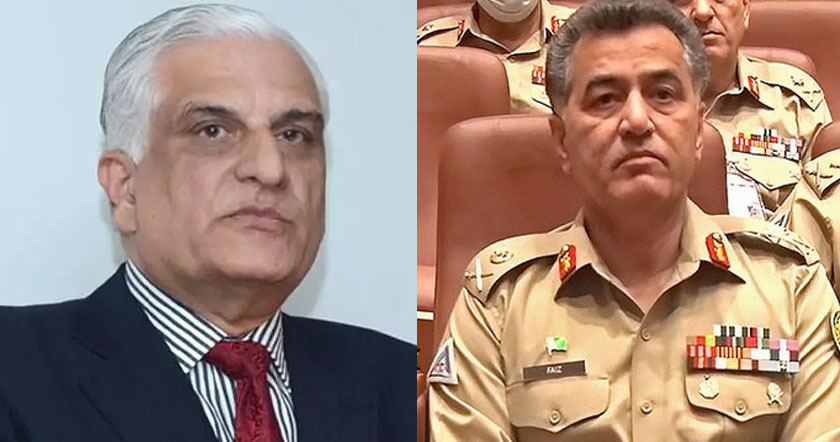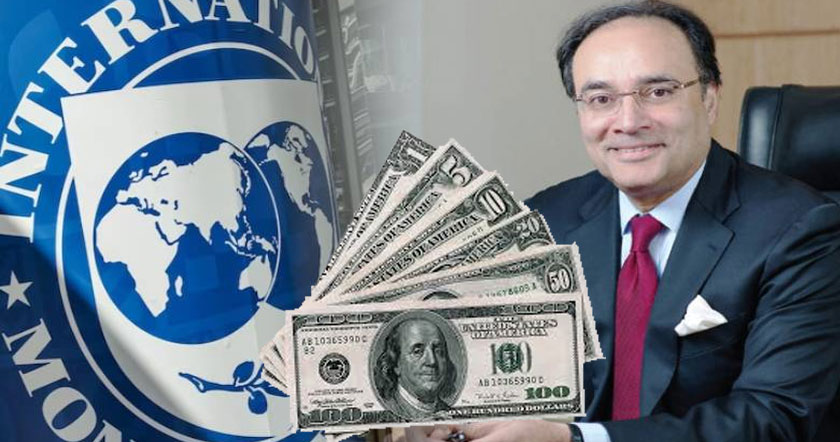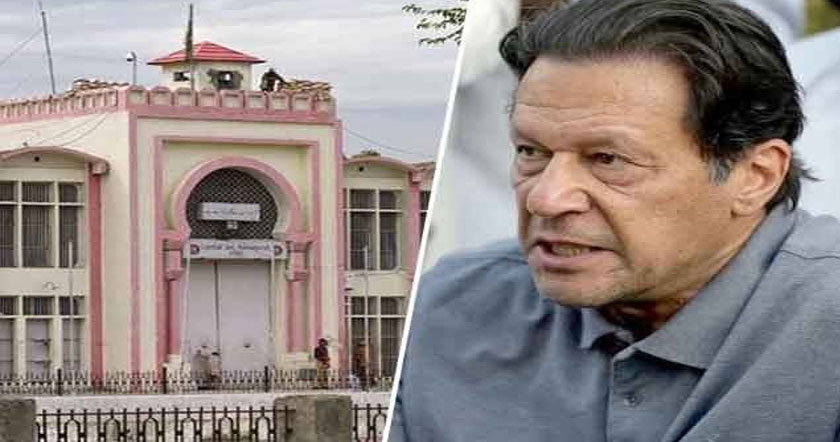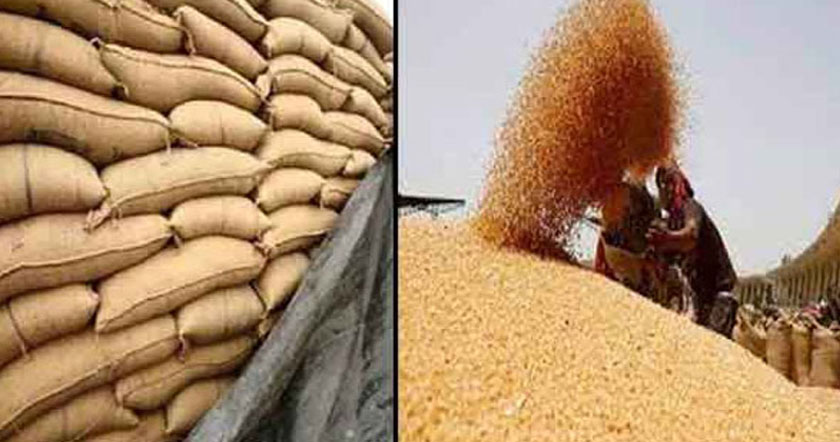Although the rate of growth has slowed since 2018, Pakistan's middle class consumer population still remains among the fastest growing in the world. In a report titled "Emerging Markets Transforming As Velocity Markets", Ogilvy and Mather, a global market communications firm, has put Pakistan among what it calls
"Velocity 12" group of economies that include Bangladesh, Brazil, China, Egypt, India, Indonesia, Mexico, Myanmar, Nigeria, Pakistan, Philippines and Vietnam. The term velocity describes both the rate of real change in the size of the middle class as well as a priority for companies as they consider business investment and marketing in V12 countries. These 12 countries will be the biggest contributors to the next billion middle class consumers, according to the report.
The Velocity 12 report says that this next billion middle-class group will:
1. Be increasingly defined by women and youth as the change agents, with purchasing power crossing cultural, religious and demographic divides.
2. Comprise the largest block of newly connected consumers on the internet, globally connected as never before – with global connectivity that is projected to double in the next five years.
3. Rapidly increase its social engagement, and brands discussion, as marketers compete in the digital marketplace for greater share of the new middle-class prize.
4. Urbanize faster than other parts of the world, dominating the future list of megacities, while creating a new “urbangea” that connects large swathes of these countries into a virtual trading zone.
5. Propel cities, more than countries, to become the unit of invention, entrepreneurship and investment.
Velocity 12:
Ogilvy and Mather's report on "Velocity 12" begins with the story of Fahima Sarkar, a Pakistani woman entrepreneur who lives in Lahore. Here is an excerpt:
"If you want to catch a glimpse of the global economic future, then meet Fahima Sarkar. In many ways, Fahima – who lives in Lahore, Pakistan – is typical of her group of friends, and a growing number of women across South Asia. After attending college, Fahima worked in sales for a Karachi-based garment company that was rapidly expanding their business in the region. She eventually left the role because she wanted to start a family. Fahima is a lot different than her own mother – both in her outlook and her lifestyle. Rather than being solely a stay at home mom, Fahima has used her time raising her child to develop a new career as an “Instapreneur,” someone who uses social media to start her own business. Her online venture (headquartered on her kitchen table): selling high-end picture frames via the Web to parents who want an upscale way to display their children’s photos at home. That was her first taste of entrepreneurship – and she turned a profit almost immediately."
"Velocity 12" report forecasts Pakistan's middle class consumer population to reach 122 million by 2025, representing a gain of 59 million members over a 10 year period from 2015 to 2025.
Reality Check:
We are almost half way through Ogilvy's 10 year forecast period. How is Pakistan doing? One indicator is the growth in vehicle ownership, particular the ownership of motorcycles.
Private vehicle ownership in Pakistan has risen sharply in 4 year period from 2015 to 2016. More than 9% of households owned cars in 2018, up from 6% in 2015. Motorcycle ownership has jumped from 41% of households in 2015 to 53% in 2018, according to data released by Federal Bureau of Statistics (FBS) recently. There are 32.2 million households in Pakistan, according to 2017 Census.
Retail Sales Growth:
Pakistan has seen retail sales climb from $145 billion in 2015 to $210 billion in 2018, according to Statista.com. Over 60 percent of the Pakistani population is between the aged of 15 to 64 years, which is the prime age of consumer spending.
With the introduction of 3G/4G services, internet penetration has risen rapidly. Internet subscriber growth in Pakistan is averaging over 22% per year and total subscribers crossed the 70 million mark in 2019. Cheap smartphones, low cost of 3G/4G services and a consumer-goods obsessed middle class has meant that Pakistan’s e-commerce sector is “mobile first”: some e-commerce start-ups claim that over 75 percent of their total business is online.
E-Commerce:
Online sales are growing much faster than the brick-and-mortar retail sales. Adam Dawood of Yayvo online portal estimates that e-tail sales are doubling every year. He expects them to pass $1 billion in the current fiscal year (2017-18), two years earlier than the previous forecast. This is being enabled by increasing broadband penetration and new online payment options. Ant Financial, an Alibaba subsidiary, has just announced the purchase of 45% stake in Pakistan-based Telenor Microfinance Bank. Bloomberg is reporting that Alibaba is in serious talks to buy Daraz.pk, an online retailer in Pakistan.
Advertising Revenue:
Growing buying power of rapidly expanding middle class in Pakistan drove the nation's media advertising revenue up 14% to a record Rs. 76.2 billion ($727 million), making the country's media market among the world's fastest growing for FY 2015-16, according to Magna Research. Half of this ad spending (Rs. 38 billion or $362 million) went to television channels while the rest was divided among print, outdoor, radio and digital media. `
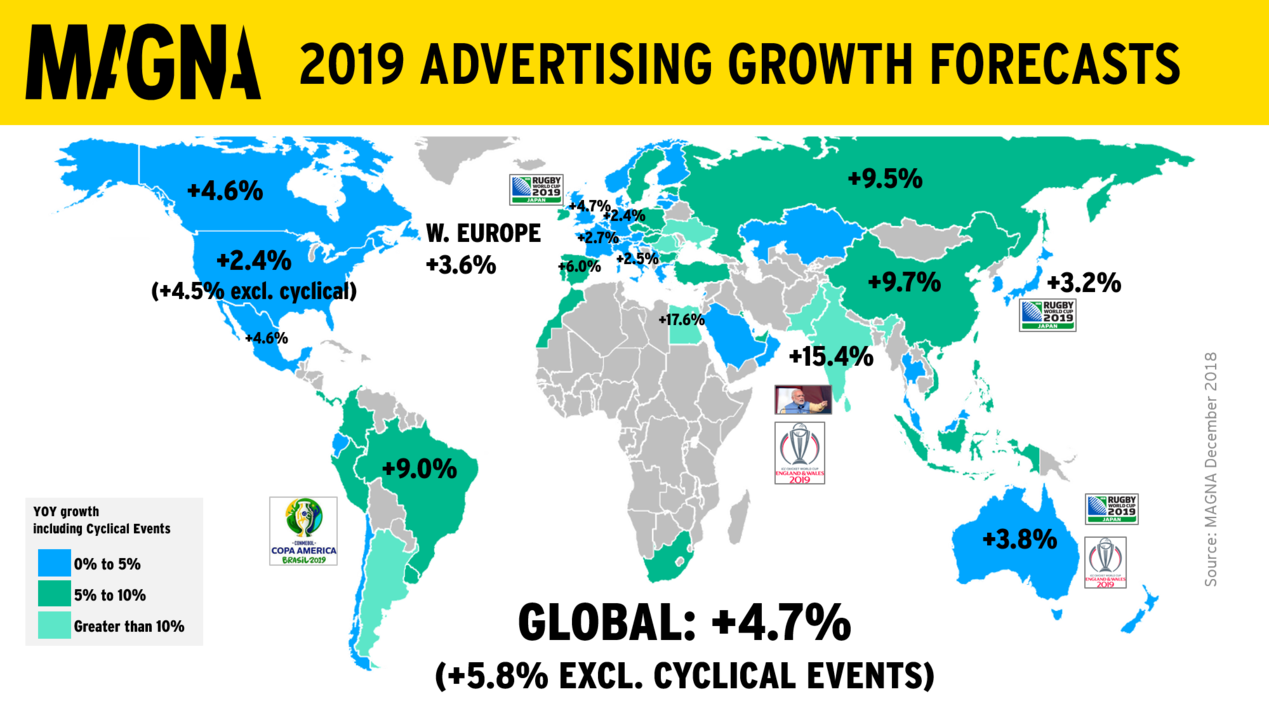
Digital media spending rose 27% in 2015-16 over prior year, the fastest of all the media platforms. It was followed by 20% increase in radio, 13% in television, 12% in print and 6% in outdoor advertising, according to data published by Aurora media market research
Mass Media Growth:
Advertising revenue has fueled media boom in Pakistan since early 2000s when Pakistan had just one television channel, according to the UK's Prospect Magazine. Today it has over 100. This boom has transformed the nation. The birth of privately owned commercial media has been enabled by the Musharraf-era deregulation, and funded by the tremendous growth in revenue from advertising targeted at the burgeoning urban middle class consumers.
Sports and Entertainment:
Sports and entertainment sectors are major beneficiaries of increasing advertising budgets. Commercial television channels' shows and serials are supported by advertisers. A quick look at Pakistan Super League 2018 matches reveals that all major consumer brand names are either directly sponsoring or buying advertising from broadcasters. These ads and sponsorship have turned PSL into a major business producing tens of millions of dollars in revenue to support cricket in Pakistan. Last year, Pakistan Cricket Board's budget was over $40 million and a big chunk of it came from PSL. This year, the PSL chairman Najam Sethi estimates the PSL franchise valuation is approaching half a billion US dollars with potentially significant revenue upside.
Downsides of Consumer Boom:
There are a couple of downsides of the consumer boom. First, a dramatic increase in solid waste. Second, rising consumption could further depress Pakistan's already low private savings rate.
FMCG products come with a significant amount of plastic and paper packaging that contribute to larger volume of trash. This will necessitate a more modern approach to solid waste disposal and recycling in Pakistani towns and cities. An absence of these systems will make the garbage situation much worse. It will pose increased environmental hazards.
Pakistan's savings rate is already in teens, making it among the lowest in the world. Further decline could hurt investments necessary for faster economic growth.
Summary:
Pakistan's $210 billion retail market is among the fastest growing in the world, according to Euromonitor. In a report titled "Emerging Markets Transforming As Velocity Markets", Ogilvy and Mather, a global market communications firm, has put Pakistan among what it calls "Velocity 12" that include Bangladesh, Brazil, China, Egypt, India, Indonesia, Mexico, Myanmar, Nigeria, Pakistan, Philippines and Vietnam. These 12 countries will be the biggest contributors to the next billion middle class consumers, according to the report. Expanding middle class, particularly millennials with rising disposable incomes, is demanding branded and packaged consumer goods ranging from personal and baby care items to food and beverage products. Strong demand for fast moving consumer goods is drawing large new investments of hundreds of millions of dollars. Rapid growth in sales of consumer products and services is driving other sectors, including retail, e-commerce, paper and packaging, advertising, media, sports and entertainment. Potential downsides of soaring consumption include increased amount of solid waste and decline in domestic savings and investment rates.
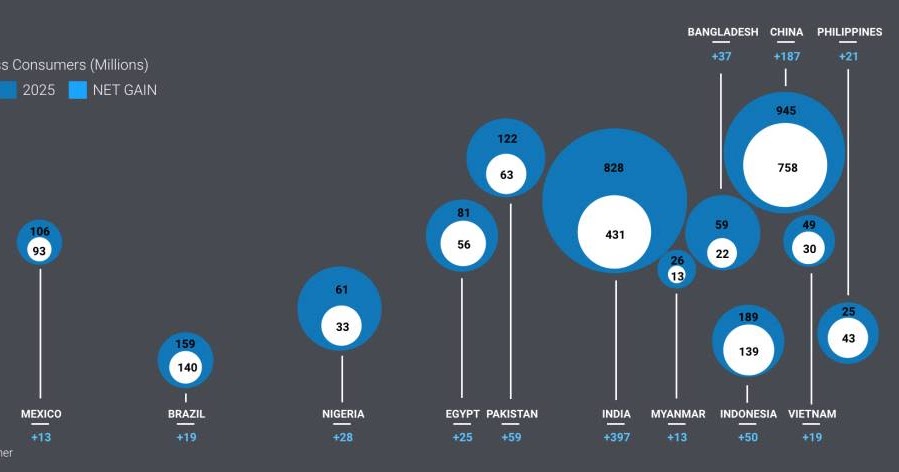
 www.riazhaq.com
www.riazhaq.com
"Velocity 12" group of economies that include Bangladesh, Brazil, China, Egypt, India, Indonesia, Mexico, Myanmar, Nigeria, Pakistan, Philippines and Vietnam. The term velocity describes both the rate of real change in the size of the middle class as well as a priority for companies as they consider business investment and marketing in V12 countries. These 12 countries will be the biggest contributors to the next billion middle class consumers, according to the report.
The Velocity 12 report says that this next billion middle-class group will:
1. Be increasingly defined by women and youth as the change agents, with purchasing power crossing cultural, religious and demographic divides.
2. Comprise the largest block of newly connected consumers on the internet, globally connected as never before – with global connectivity that is projected to double in the next five years.
3. Rapidly increase its social engagement, and brands discussion, as marketers compete in the digital marketplace for greater share of the new middle-class prize.
4. Urbanize faster than other parts of the world, dominating the future list of megacities, while creating a new “urbangea” that connects large swathes of these countries into a virtual trading zone.
5. Propel cities, more than countries, to become the unit of invention, entrepreneurship and investment.
Velocity 12:
Ogilvy and Mather's report on "Velocity 12" begins with the story of Fahima Sarkar, a Pakistani woman entrepreneur who lives in Lahore. Here is an excerpt:
"If you want to catch a glimpse of the global economic future, then meet Fahima Sarkar. In many ways, Fahima – who lives in Lahore, Pakistan – is typical of her group of friends, and a growing number of women across South Asia. After attending college, Fahima worked in sales for a Karachi-based garment company that was rapidly expanding their business in the region. She eventually left the role because she wanted to start a family. Fahima is a lot different than her own mother – both in her outlook and her lifestyle. Rather than being solely a stay at home mom, Fahima has used her time raising her child to develop a new career as an “Instapreneur,” someone who uses social media to start her own business. Her online venture (headquartered on her kitchen table): selling high-end picture frames via the Web to parents who want an upscale way to display their children’s photos at home. That was her first taste of entrepreneurship – and she turned a profit almost immediately."
"Velocity 12" report forecasts Pakistan's middle class consumer population to reach 122 million by 2025, representing a gain of 59 million members over a 10 year period from 2015 to 2025.
Reality Check:
We are almost half way through Ogilvy's 10 year forecast period. How is Pakistan doing? One indicator is the growth in vehicle ownership, particular the ownership of motorcycles.
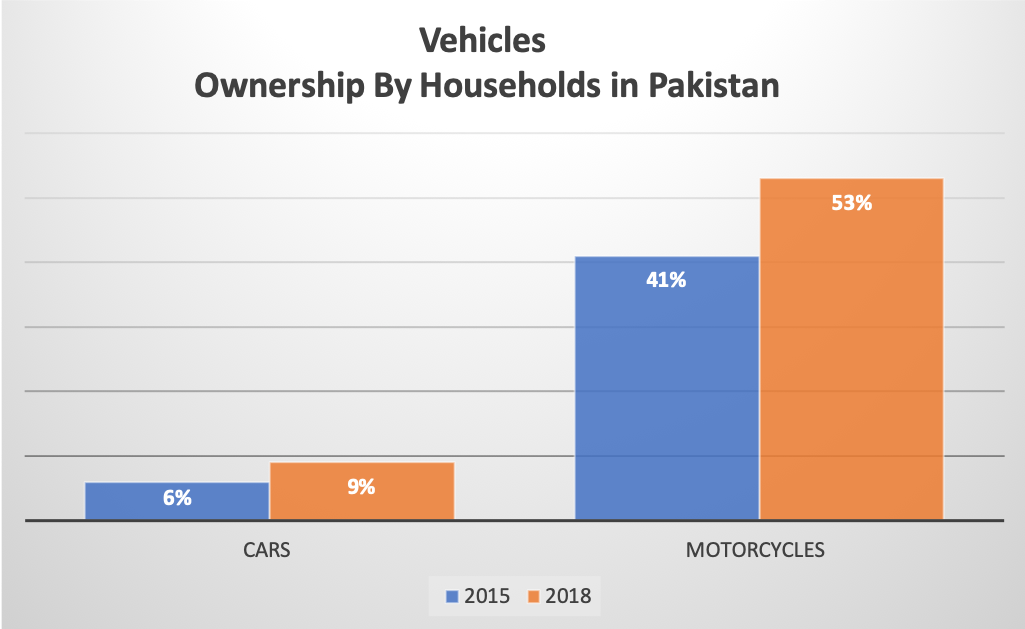
|
| Vehicle Ownership. Source: PBS |
Private vehicle ownership in Pakistan has risen sharply in 4 year period from 2015 to 2016. More than 9% of households owned cars in 2018, up from 6% in 2015. Motorcycle ownership has jumped from 41% of households in 2015 to 53% in 2018, according to data released by Federal Bureau of Statistics (FBS) recently. There are 32.2 million households in Pakistan, according to 2017 Census.
Retail Sales Growth:
Pakistan has seen retail sales climb from $145 billion in 2015 to $210 billion in 2018, according to Statista.com. Over 60 percent of the Pakistani population is between the aged of 15 to 64 years, which is the prime age of consumer spending.
With the introduction of 3G/4G services, internet penetration has risen rapidly. Internet subscriber growth in Pakistan is averaging over 22% per year and total subscribers crossed the 70 million mark in 2019. Cheap smartphones, low cost of 3G/4G services and a consumer-goods obsessed middle class has meant that Pakistan’s e-commerce sector is “mobile first”: some e-commerce start-ups claim that over 75 percent of their total business is online.
E-Commerce:
Online sales are growing much faster than the brick-and-mortar retail sales. Adam Dawood of Yayvo online portal estimates that e-tail sales are doubling every year. He expects them to pass $1 billion in the current fiscal year (2017-18), two years earlier than the previous forecast. This is being enabled by increasing broadband penetration and new online payment options. Ant Financial, an Alibaba subsidiary, has just announced the purchase of 45% stake in Pakistan-based Telenor Microfinance Bank. Bloomberg is reporting that Alibaba is in serious talks to buy Daraz.pk, an online retailer in Pakistan.
Advertising Revenue:
Growing buying power of rapidly expanding middle class in Pakistan drove the nation's media advertising revenue up 14% to a record Rs. 76.2 billion ($727 million), making the country's media market among the world's fastest growing for FY 2015-16, according to Magna Research. Half of this ad spending (Rs. 38 billion or $362 million) went to television channels while the rest was divided among print, outdoor, radio and digital media. `

Digital media spending rose 27% in 2015-16 over prior year, the fastest of all the media platforms. It was followed by 20% increase in radio, 13% in television, 12% in print and 6% in outdoor advertising, according to data published by Aurora media market research
Mass Media Growth:
Advertising revenue has fueled media boom in Pakistan since early 2000s when Pakistan had just one television channel, according to the UK's Prospect Magazine. Today it has over 100. This boom has transformed the nation. The birth of privately owned commercial media has been enabled by the Musharraf-era deregulation, and funded by the tremendous growth in revenue from advertising targeted at the burgeoning urban middle class consumers.
Sports and Entertainment:
Sports and entertainment sectors are major beneficiaries of increasing advertising budgets. Commercial television channels' shows and serials are supported by advertisers. A quick look at Pakistan Super League 2018 matches reveals that all major consumer brand names are either directly sponsoring or buying advertising from broadcasters. These ads and sponsorship have turned PSL into a major business producing tens of millions of dollars in revenue to support cricket in Pakistan. Last year, Pakistan Cricket Board's budget was over $40 million and a big chunk of it came from PSL. This year, the PSL chairman Najam Sethi estimates the PSL franchise valuation is approaching half a billion US dollars with potentially significant revenue upside.
Downsides of Consumer Boom:
There are a couple of downsides of the consumer boom. First, a dramatic increase in solid waste. Second, rising consumption could further depress Pakistan's already low private savings rate.
FMCG products come with a significant amount of plastic and paper packaging that contribute to larger volume of trash. This will necessitate a more modern approach to solid waste disposal and recycling in Pakistani towns and cities. An absence of these systems will make the garbage situation much worse. It will pose increased environmental hazards.
Pakistan's savings rate is already in teens, making it among the lowest in the world. Further decline could hurt investments necessary for faster economic growth.
Summary:
Pakistan's $210 billion retail market is among the fastest growing in the world, according to Euromonitor. In a report titled "Emerging Markets Transforming As Velocity Markets", Ogilvy and Mather, a global market communications firm, has put Pakistan among what it calls "Velocity 12" that include Bangladesh, Brazil, China, Egypt, India, Indonesia, Mexico, Myanmar, Nigeria, Pakistan, Philippines and Vietnam. These 12 countries will be the biggest contributors to the next billion middle class consumers, according to the report. Expanding middle class, particularly millennials with rising disposable incomes, is demanding branded and packaged consumer goods ranging from personal and baby care items to food and beverage products. Strong demand for fast moving consumer goods is drawing large new investments of hundreds of millions of dollars. Rapid growth in sales of consumer products and services is driving other sectors, including retail, e-commerce, paper and packaging, advertising, media, sports and entertainment. Potential downsides of soaring consumption include increased amount of solid waste and decline in domestic savings and investment rates.

Pakistan's Middle Class Consumer Population Among World's Fastest Growing
News, analysis and opinions about India, Pakistan, US, Canada, Europe, Mid East, South Asia, Silicon Valley, High Technology, Economy, Politics, World


